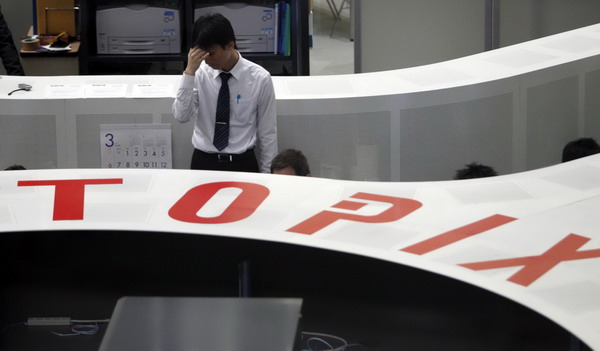Global Reaction
Japan feeds more money to banks as stocks slump
(Agencies)
Updated: 2011-03-15 15:26
 |
Large Medium Small |
|
 Employees of the Tokyo Stock Exchange (TSE) work at the bourse in Tokyo March 14, 2011. [Photo/Agencies]
|
The injections have helped stabilize currency markets. But stock markets dived for a second day as investors unloaded assets amid escalating worries of a nuclear crisis.
The benchmark Nikkei 225 stock average slid as much as 14 percent after Prime Minister Naoto Kan warned residents near a damaged nuclear power plant in tsunami-ravaged northeastern Japan to stay inside or risk getting radiation sickness. By mid afternoon, the index was down about 9 percent.
Radiation is leaking from damaged reactors at the crippled plant in a dramatic escalation of the 4-day-old catastrophe. Kan said there is dangers of more leaks and told people living within 19 miles (30 kilometers) of the Fukushima Dai-ichi complex to stay indoors.
The Bank of Japan has moved quickly to try to keep financial markets calm. By flooding the banking system with cash, it hopes banks will continue lending money and meet the likely surge in demand for post-earthquake funds.
Analysts say Japan can tap its vast bond market to help pay for reconstruction in the coastal regions shattered by the tsunami that the quake spawned. But it will add to strains on the national finances. The country is saddled with massive debt that, at 200 percent of gross domestic product, is the biggest among developed nations.
"Japan will be poorer, for this disaster," said Peter Morici, a business professor at the University of Maryland. "Rebuilding will run down Japan's financial wealth."
The central bank's nine-member policy board also voted unanimously Monday to ease monetary policy. It will expand the size of an existing program to buy assets _ such as government and corporate bonds- by 5 trillion yen to 40 trillion yen ($486.4 billion). It kept its key interest rate at virtually zero.
Credit Suisse economist Hiromichi Shirakawa and analysts at Barclays Capital estimated the damage at up to 15 trillion yen ($183 billion)- about 3 percent of gross domestic product. Other experts warned the economy will shrink for two straight quarters.
That represents a painful blow for Japan which lost its place as the world's No 2 economy to China last year. The Japanese economy has been ailing for two decades, barely managing to eke out weak growth between slowdowns. It is saddled with a massive public debt that, at 200 percent of GDP, is the biggest among industrialized nations.
Morici said the nuclear crisis combined with the twin hit from the quake and tsunami could make Japan more vulnerable than it was in the past.
"The double whammy has the potential to keep the Japanese economy shut down longer and globalization offers Japan's export customers alternatives they might not have enjoyed a decade or two ago," he said. "Hyundai and Ford now are good substitutes for Toyota's cars, and even more so, Caterpillar tractors made in China can replace Komatsu's land movers."
The four most severely affected prefectures (states) in the northeast- Iwate, Miyagi, Fukushima and Ibaraki- account for about 6 percent of Japan's economy.
Power supply has failed in the worst affected areas and power rationing may be imposed in other regions. Ports are closed, steel plants have stopped producing, and several major oil refineries have shut down. Getting manufacturing up and working again may be a bigger challenge than in the catastrophic 1995 Kobe earthquake because a larger area is affected.
In the northeastern city of Sendai, the railway station stood deserted. State television footage showed ceilings and walkways collapsed onto the platforms, walls warped and leaning onto the tracks. There was no indication when the station and lines running through could be repaired and operating again.
The northeast is also a major center for car production, with a myriad of parts suppliers and a network of roads and ports for efficient shipments. Toyota Motor Corp said it would suspend manufacturing at its domestic plants through Wednesday- a production loss of 40,000 cars. Other manufacturers including Sony Corp. and Honda Motor Co. were also forced to halt production.
"There is no way to get our products out, even if we make them, with the roads and distribution system damaged," said Honda Motor Co spokeswoman Natsuno Asanuma.
The aftermath is being felt nationwide.
Four nuclear plants were damaged in the temblors, causing widespread power shortages. Trains in Tokyo, the nation's capital, usually run like clockwork. But are running on a reduced schedule or stopped entirely, preventing millions of commuters from reaching workplaces.
Billions of dollars are expected to be needed to rebuild homes, roads and other infrastructure requiring public spending that will benefit construction companies but add to the national debt.
The economy will eventually get a boost from reconstruction but "this does not mean that Japan is better off," said Julian Jessop, chief international economist at Capital Economics in London. It's a quirk of accounting that destruction of assets is not counted as a reduction in the economy but replacement of those assets boosts economic activity, he said.
Credit Suisse's Shirakawa said in a report the direct economic losses such as property destruction could total 6 trillion yen ($73 billion) to 7 trillion yen. Indirect losses such as lost production will probably be higher.
Other estimates are more pessimistic.
"At the end of the day, this will probably cost a few hundred billion dollars," said Song Seng Wun, economist with CIMB-GK Research in Singapore. "It's going to be a big strain on public finances."
| 分享按钮 |



